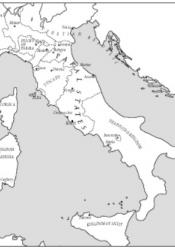Early 19th Century Rome
Mr. Rochester divulges the truth to Jane following the debauchery of their wedding day. After telling her about his early years with Bertha, Mr. Rochester then explains his travel. “For ten long years I roved about, living first in one capital, then another: sometimes in St. Petersburg; oftener in Paris; occasionally in Rome, Naples, and Florence” (Brontë ch. 27). This is significant because Mr. Rochester’s marriage to Bertha affords him “plenty of money,” as well as the ability to choose his “own society” because his marriage is not publicly known (Brontë ch. 27).
Of the capitals Mr. Rochester lists, at the turn of the 19th century, Rome “was ruled by the pope, an elected monarch,” but would soon “fall to the armies of revolutionary France” lead by Napoleon (Nicassio 13, 15). This is important because at the time 21- to 30-year-olds made up “the largest single age group,” in Rome, though men outnumbered women (Nicassio 55). Mr. Rochester speaks of his female conquests, including his Italian mistress, Giacinta (Brontë ch. 27). At the time “Roman women had a reputation of beauty and independence” which were no doubt noticed by “the large floating population of unattached male pilgrims and tourists” who aided in outnumbering the female population (Nicassio 56). With the inclusion of Mr. Rochester’s travels to capitals like Rome, Brontë is further illustrating the divide between men and women, conflating the societal double standards of the genders in Jane Eyre.
Nicassio, Susan Vandiver. “Imperial City: Rome Under Napoleon.” University of Chicago Press, 2005. pascal-ccu.primo.exlibrisgroup.com/permalink/01PASCAL_CCU/nil3jg/cdi_proquest_ebookcentral_EBC485978, Accessed 18 Jun. 2022.

